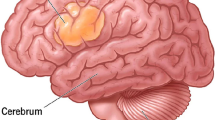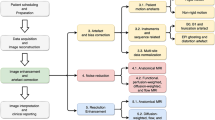Abstract
Objectives
This study aimed to examine the equivalence of computed tomography (CT)–based synthetic T1-weighted imaging (T1WI) to conventional T1WI for the quantitative assessment of brain morphology.
Materials and methods
This prospective study examined 35 adult patients undergoing brain magnetic resonance imaging (MRI) and CT scans. An image synthesis method based on a deep learning model was used to generate synthetic T1WI (sT1WI) from CT data. Two senior radiologists used sT1WI and conventional T1WI on separate occasions to independently measure clinically relevant brain morphological parameters. The reliability and consistency between conventional and synthetic T1WI were assessed using statistical consistency checks, comprising intra-reader, inter-reader, and inter-method agreement.
Results
The intra-reader, inter-reader, and inter-method reliability and variability mostly exhibited the desired performance, except for several poor agreements due to measurement differences between the radiologists. All the measurements of sT1WI were equivalent to that of T1WI at 5% equivalent intervals.
Conclusion
This study demonstrated the equivalence of CT-based sT1WI to conventional T1WI for quantitatively assessing brain morphology, thereby providing more information on imaging diagnosis with a single CT scan.
Clinical relevance statement
Real-time synthesis of MR images from CT scans reduces the time required to acquire MR signals, improving the efficiency of the treatment planning system and providing benefits in the clinical diagnosis of patients with contraindications such as presence of metal implants or claustrophobia.
Key Points
• Deep learning–based image synthesis methods generate synthetic T1-weighted imaging from CT scans.
• The equivalence of synthetic T1-weighted imaging and conventional MRI for quantitative brain assessment was investigated.
• Synthetic T1-weighted imaging can provide more information per scan and be used in preoperative diagnosis and radiotherapy.





Similar content being viewed by others
Abbreviations
- AIS:
-
Acute ischemic stroke
- BAHLV:
-
Angle formed by the bilateral anterior horns of the lateral ventricles
- BPHLV:
-
Angle formed by the bilateral posterior horns of the lateral ventricles
- CT:
-
Computed tomography
- CTLCC:
-
Cortical thickness of the left cingulate cortex
- CTRCC:
-
Cortical thickness of the right cingulate cortex
- DKCCPP:
-
Distance between knee of the corpus callosum and pressing part
- GAN:
-
Generative adversarial network
- HCC:
-
Height of the corpus callosum
- ICC:
-
Intra-class correlation coefficient
- IH:
-
Intracranial height
- IL:
-
Intracranial length
- IW:
-
Intracranial width
- LEL:
-
Left eyeball length
- LEW:
-
Left eyeball width
- LLVAAD:
-
Left lateral ventricle anteroposterior angle distance
- LTL:
-
Left thalamus length
- LTW:
-
Left thalamus width
- MPR:
-
Multi-planar reconstruction
- MRI:
-
Magnetic resonance imaging
- PL:
-
Pontine length
- PW:
-
Pontine width
- REL:
-
Right eyeball length
- REW:
-
Right eyeball width
- RLVAAD:
-
Right lateral ventricle anteroposterior angle distance
- RTL:
-
Right thalamus length
- RTW:
-
Right thalamus width
- sMRI:
-
Synthetic magnetic resonance imaging
- sT1WI:
-
Synthetic T1-weighted image
- TPS:
-
Treatment planning system
References
Zhang W, Cheng J, Zhang Y, Wang K, Jin H (2019) Analysis of CT and MRI combined examination for the diagnosis of acute cerebral infarction. J Coll Physicians Surg Pak 29:898–899
Lee HJ, Kim MJ, Choi JY, Hong HS, Kim KA (2011) Relative accuracy of CT and MRI in the differentiation of benign from malignant pancreatic cystic lesions. Clin Radiol 66:315–321
Schmidt MA, Payne GS (2015) Radiotherapy planning using MRI. Phys Med Biol 60:R323–R361
Glide-Hurst CK, Low DA, Orton CG (2014) MRI/CT is the future of radiotherapy treatment planning. Med Phys 41:110601
Fox T, Elder E, Crocker I (2008) Chapter 3 - Image registration and fusion techniques. In: Paulino AC, Teh BS (eds) PET-CT in Radiotherapy Treatment Planning. Elsevier, Philadelphia, pp 35–51
Hsu S-H, Cao Y, Huang K, Feng M, Balter JM (2013) Investigation of a method for generating synthetic CT models from MRI scans of the head and neck for radiation therapy. Phys Med Biol 58:8419–8435
Lei Y, Harms J, Wang T et al (2019) MRI-based synthetic CT generation using semantic random forest with iterative refinement. Phys Med Biol 64:085001
Hsu SH, Dupre P, Peng Q, Tomé WA (2020) A technique to generate synthetic CT from MRI for abdominal radiotherapy. J Appl Clin Med Phys 21:136–143
Han X (2017) MR-based synthetic CT generation using a deep convolutional neural network method. Med Phys 44:1408–1419
Yang H, Sun J, Carass A et al (2020) Unsupervised MR-to-CT synthesis using structure-constrained CycleGAN. IEEE Trans Med Imaging 39:4249–4261
Florkow MC, Zijlstra F, Willemsen K et al (2020) Deep learning–based MR-to-CT synthesis: the influence of varying gradient echo–based MR images as input channels. Magn Reson Med 83:1429–1441
Li Y, Li W, Xiong J, Xia J, Xie Y (2020) Comparison of supervised and unsupervised deep learning methods for medical image synthesis between computed tomography and magnetic resonance images. Biomed Res Int 2020:5193707
Morbée L, Chen M, Van Den Berghe T et al (2022) MRI-based synthetic CT of the hip: can it be an alternative to conventional CT in the evaluation of osseous morphology? Eur Radiol 32:3112–3120
Morbée L, Chen M, Herregods N, Pullens P, Jans LBO (2021) MRI-based synthetic CT of the lumbar spine: geometric measurements for surgery planning in comparison with CT. Eur J Radiol 144:109999
Jin C-B, Kim H, Liu M et al (2019) Deep CT to MR synthesis using paired and unpaired data. Sensors (Basel) 19:2361
Li W, Li Y, Qin W et al (2020) Magnetic resonance image (MRI) synthesis from brain computed tomography (CT) images based on deep learning methods for magnetic resonance (MR)-guided radiotherapy. Quant Imaging Med Surg 10:1223–1236
Jin C-B, Kim H, Liu M et al (2019) DC2Anet: generating lumbar spine MR images from cT scan data based on semi-supervised learning. Appl Sci 9:2521
Gu S, Timofte R (2019) A brief review of image denoising algorithms and beyond. Springer International Publishing, Cham, pp 1–21
Wang H, Yang P, Xu C, Min L, Wang S, Xu B (2022) Lung CT image enhancement based on total variational frame and wavelet transform. Int J Imaging Syst Technol 32:1604–1614
Li Z, Huang X, Zhang Z et al (2022) Synthesis of magnetic resonance images from computed tomography data using convolutional neural network with contextual loss function. Quant Imaging Med Surg 12:3151–3169
Marques JP, Kober T, Krueger G, van der Zwaag W, Van de Moortele P-F, Gruetter R (2010) MP2RAGE, a self bias-field corrected sequence for improved segmentation and T1-mapping at high field. Neuroimage 49:1271–1281
Benchoufi M, Matzner-Lober E, Molinari N, Jannot AS, Soyer P (2020) Interobserver agreement issues in radiology. Diagn Interv Imaging 101:639–641
Engesæter IØ, Laborie LB, Lehmann TG et al (2012) Radiological findings for hip dysplasia at skeletal maturity. Validation of digital and manual measurement techniques. Skelet Radiol 41:775–785
de Vet HCW, Terwee CB, Knol DL, Bouter LM (2006) When to use agreement versus reliability measures. J Clin Epidemiol 59:1033–1039
Vogrig C, Louis JS, Avila F et al (2021) Synthetic MRI is not yet ready for morphologic and functional assessment of patellar cartilage at 1.5Tesla. Diagn Interv Imaging 102:181–187
Spadea MF, Maspero M, Zaffino P, Seco J (2021) Deep learning based synthetic-CT generation in radiotherapy and PET: a review. Med Phys 48:6537–6566
Cusumano D, Placidi L, Teodoli S et al (2020) On the accuracy of bulk synthetic CT for MR-guided online adaptive radiotherapy. Radiol Med 125:157–164
Florkow MC, Willemsen K, Zijlstra F et al (2022) MRI-based synthetic CT shows equivalence to conventional CT for the morphological assessment of the hip joint. J Orthop Res 40:954–964
Liu L, Johansson A, Cao Y, Dow J, Lawrence TS, Balter JM (2020) Abdominal synthetic CT generation from MR Dixon images using a U-net trained with ‘semi-synthetic’CT data. Phys Med Biol 65:125001
Wang Y, Liu C, Zhang X, Deng W (2019) Synthetic CT generation based on T2 weighted MRI of nasopharyngeal carcinoma (NPC) using a deep convolutional neural network (DCNN). Front Oncol 9:1333
Hu N, Zhang T, Wu Y et al (2022) Detecting brain lesions in suspected acute ischemic stroke with CT-based synthetic MRI using generative adversarial networks. Ann Transl Med 10:35
Acknowledgements
We thank the Institute of Medical Technology, Peking University Health Science Center for technical support and Shenzhen Second People’s Hospital for data collection.
Funding
This work was supported by the National Natural Science Foundation of China (Grant No. 12075011, No. 82071280, and No. 82171913), the Natural Science Research of Jiangsu Higher Education Institutions of China (No. 23KJB310019), and the Key Research and Development Program of Science and Technology Planning Project of Tibet Autonomous Region, China (Grant No. XZ202001ZY0005G).
Author information
Authors and Affiliations
Contributions
All authors contributed to the study conception and design. Material preparation, data collection, and analysis were performed by Zhaotong Li, Gan Cao, Li Zhang, and Jichun Yuan. The first draft of the manuscript was written by Zhaotong Li and Gan Cao, and all authors commented on previous versions of the manuscript. All authors read and approved the final manuscript.
Corresponding authors
Ethics declarations
Guarantor
The scientific guarantor of this publication is Dr. Jun Xia.
Conflict of interest
The authors of this manuscript declare no relationships with any companies, whose products or services may be related to the subject matter of the article.
Statistics and biometry
No complex statistical methods were necessary for this paper.
Informed consent
Written informed consent was obtained from all subjects (patients) in this study.
Ethical approval
This study was performed in line with the principles of the Declaration of Helsinki. The study’s protocol was also approved by the local medical ethics committee of Shenzhen Second People’s Hospital.
Study subjects or cohorts overlap
No study subjects or cohorts have been previously reported.
Methodology
• prospective
• cross-sectional study/observational study
• multi-center study
Additional information
Publisher's Note
Springer Nature remains neutral with regard to jurisdictional claims in published maps and institutional affiliations.
Supplementary Information
Below is the link to the electronic supplementary material.
Rights and permissions
Springer Nature or its licensor (e.g. a society or other partner) holds exclusive rights to this article under a publishing agreement with the author(s) or other rightsholder(s); author self-archiving of the accepted manuscript version of this article is solely governed by the terms of such publishing agreement and applicable law.
About this article
Cite this article
Li, Z., Cao, G., Zhang, L. et al. Feasibility study on the clinical application of CT-based synthetic brain T1-weighted MRI: comparison with conventional T1-weighted MRI. Eur Radiol (2024). https://doi.org/10.1007/s00330-023-10534-1
Received:
Revised:
Accepted:
Published:
DOI: https://doi.org/10.1007/s00330-023-10534-1




